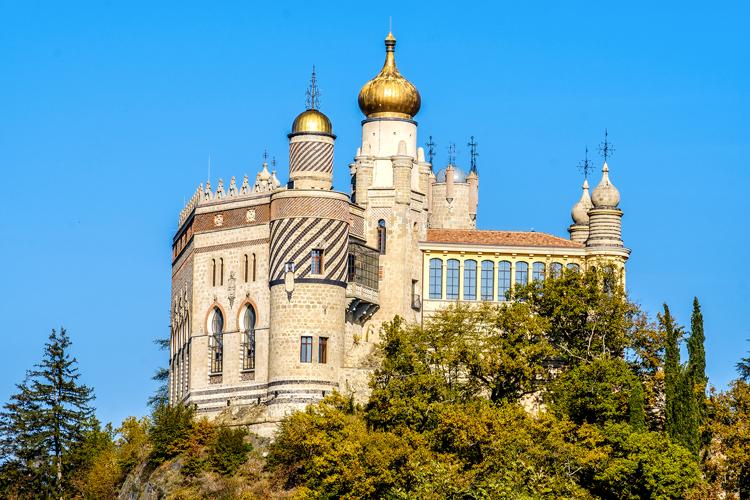There’s no other building in Emilia-Romagna - or the rest of Italy for that matter, except perhaps for the Castello di Sammezzano in Tuscany - quite like the Rocchetta Mattei.
Rising on top of a hill above the village of Riola di Vergato, in the Bolognese Apennines, this ‘small fortress’ (= rocchetta) displays a mix of Arab, Norman and Gothic features, with golden, onion-shaped domes, minarets, square and cylindrical towers and turrets you’d be more likely to see in the Middle East than in Italy.
When you visit the Rocchetta Mattei, you can almost picture Count Cesare Mattei, the man who commissioned its construction, hunched in his laboratory working on his latest electro-homeopathy remedy.

[Inside the outstanding Rocchetta Mattei. Photo credit rocchettamattei-riola.it.]
You may have never heard of Cesare Mattei, but, in the 19th century, when he lived, he was famous around the world as the inventor of electro-homeopathy, a cure derivative of homeopathy based on re-establishing a balance between the two electric charges of the body to bring the area affected by an illness to a neutral state again, using botanical extracts.
Electro-homeopathy was dismissed by official medicine as non-sense, but, in the 19th century, when Mattei practiced, people flocked to the Rocchetta to be cured. And not just regular people: even nobles and royals from all over Europe, including the Czar Alexander II and Ludwig III King of Baviera, came to this otherwise isolated village in the Apennine mountains one hour south of Bologna. It was actually thanks to the popularity of Mattei’s treatment that a railway line (the Porrettana) was built to connect the area to Bologna; and the number of visitors meant a newfound prosperity for the local residents.
The story of the Rocchetta Mattei is strictly intertwined with the story of Cesare Mattei, who picked the location because of its isolation and proximity to nature (and also because the area is rich in iron which supposedly works well with the electro-magnetic field). Construction of the Rocchetta began in 1850 on the ruins of a pre-existing fortress controlled by the powerful feudal ruler Matilde di Canossa. Nine years later, Mattei moved into the building where he lived until his death, leading the life of a medieval lord, even surrounded by his own court.

[Rocchetta Mattei is in the Apennines south of Bologna. Photo credit rocchettamattei-riola.it.]
Mattei closely supervised the construction of the Rocchetta and infused it with esoteric symbols. The underlying message was: seek the truth beyond your senses, don’t stop at what you see.
The symbolism begins right as you enter and step into the courtyard passing below a curved arc: you’re accessing the light, or, in other words, recovery from illness.
You’ll learn about some of these symbols and the many anecdotes surrounding the life of Mattei thanks to the knowledgeable guides who lead one-and-a-half-hour tours of the Rocchetta (advance reservation is mandatory) and take you into the fortress’ maze of rooms, staircases, courtyards, and terraces. Every space surprises you; highlights include the ‘Courtyard of the Lions’ (Cortile dei Leoni), a reproduction of the courtyard of the Alhambra; the ‘Chapel’ (Cappella, the music room of the church), a breathtaking reproduction of the interior of Cordoba’s Mezquita; Cesare Mattei’s bedroom, a small room with tiny windows and a stalactite ceiling where original furniture and the count’s pipes are on display; the ‘Visions’ Staircase’ (Scala delle visioni) where an allegorical depiction in the vault signifies the new homeopathic science winning over traditional medicine; Mattei’s tomb, an ark covered with maiolica.

[The 'Chapel' room. Photo credit rocchettamattei-riola.it.]
My favorite space of all is the ‘Room of the 90’ (Sala dei Novanta), a large room that was to host Mattei’s 90th birthday party, where the attendees were to be 90 people 90 years old (!). Unfortunately, Mattei died before he reached that age. But his legacy definitely lives on in the Rocchetta.
After Cesare Mattei’s death, the Rocchetta fell into disrepair and for many years it was closed. It reopened in August 2015, and has experienced tremendous success in the number of visitors since. Access is only by guided visit. For information and reservations, visit the Rocchetta Mattei’s website.



